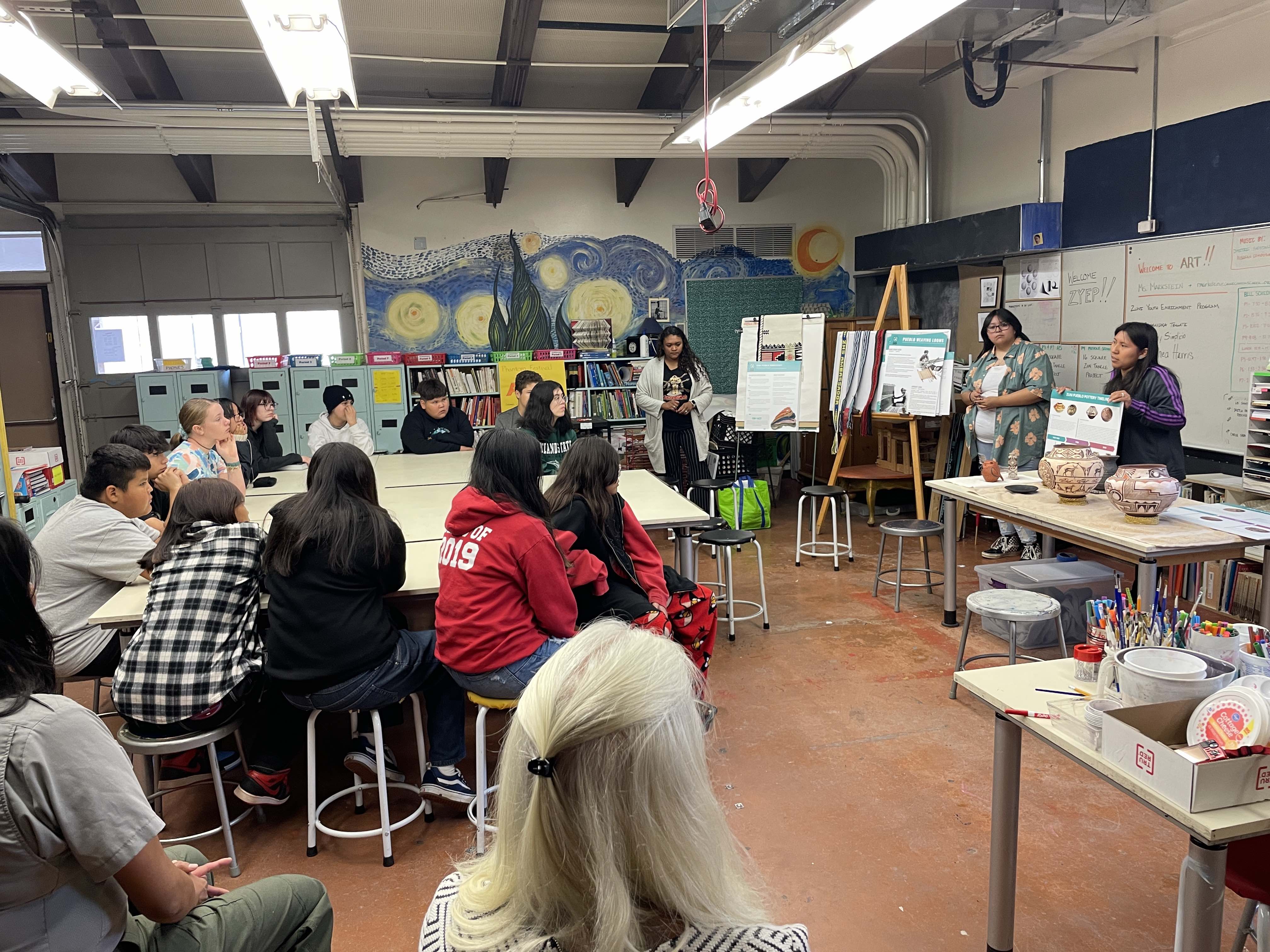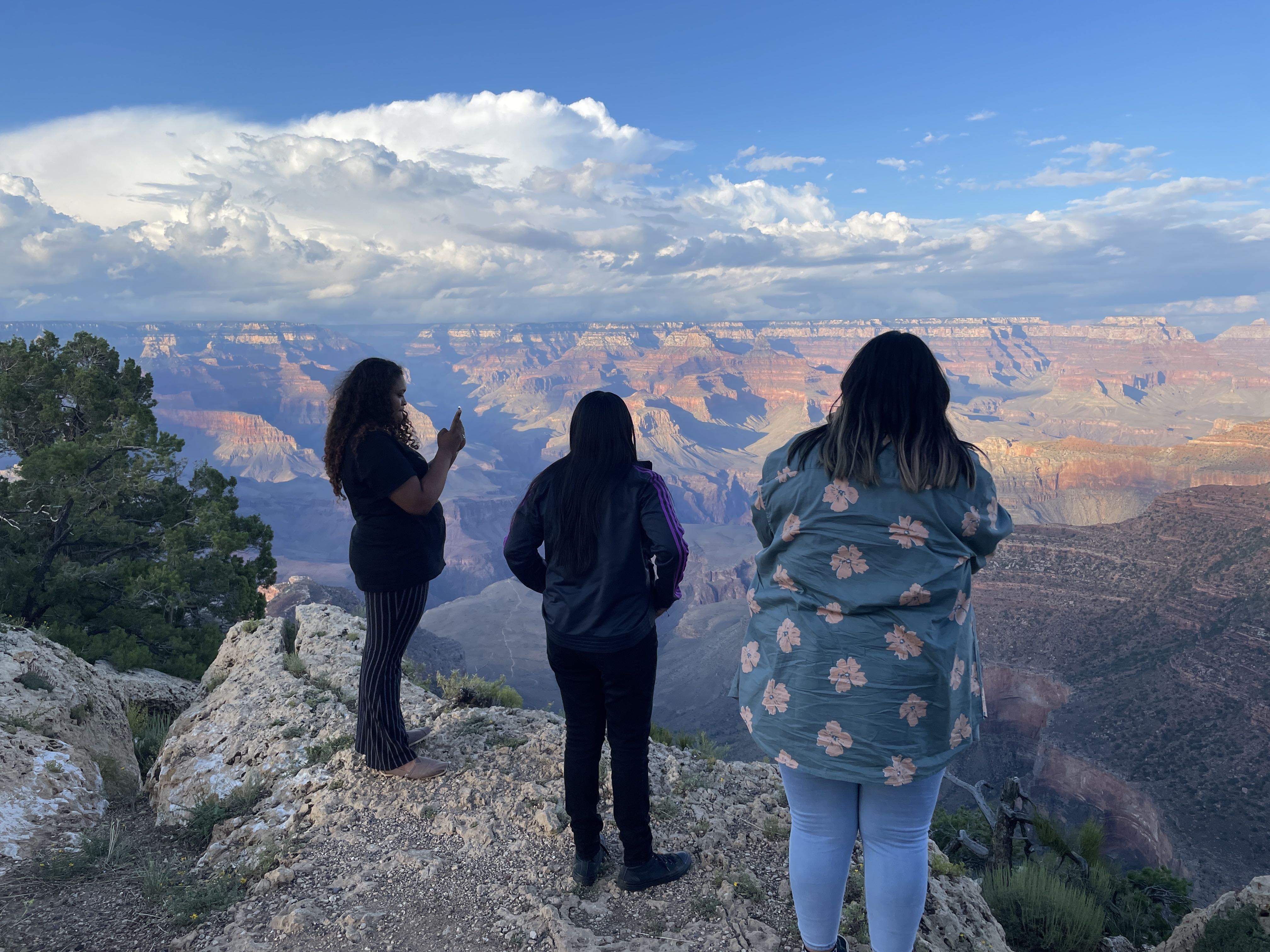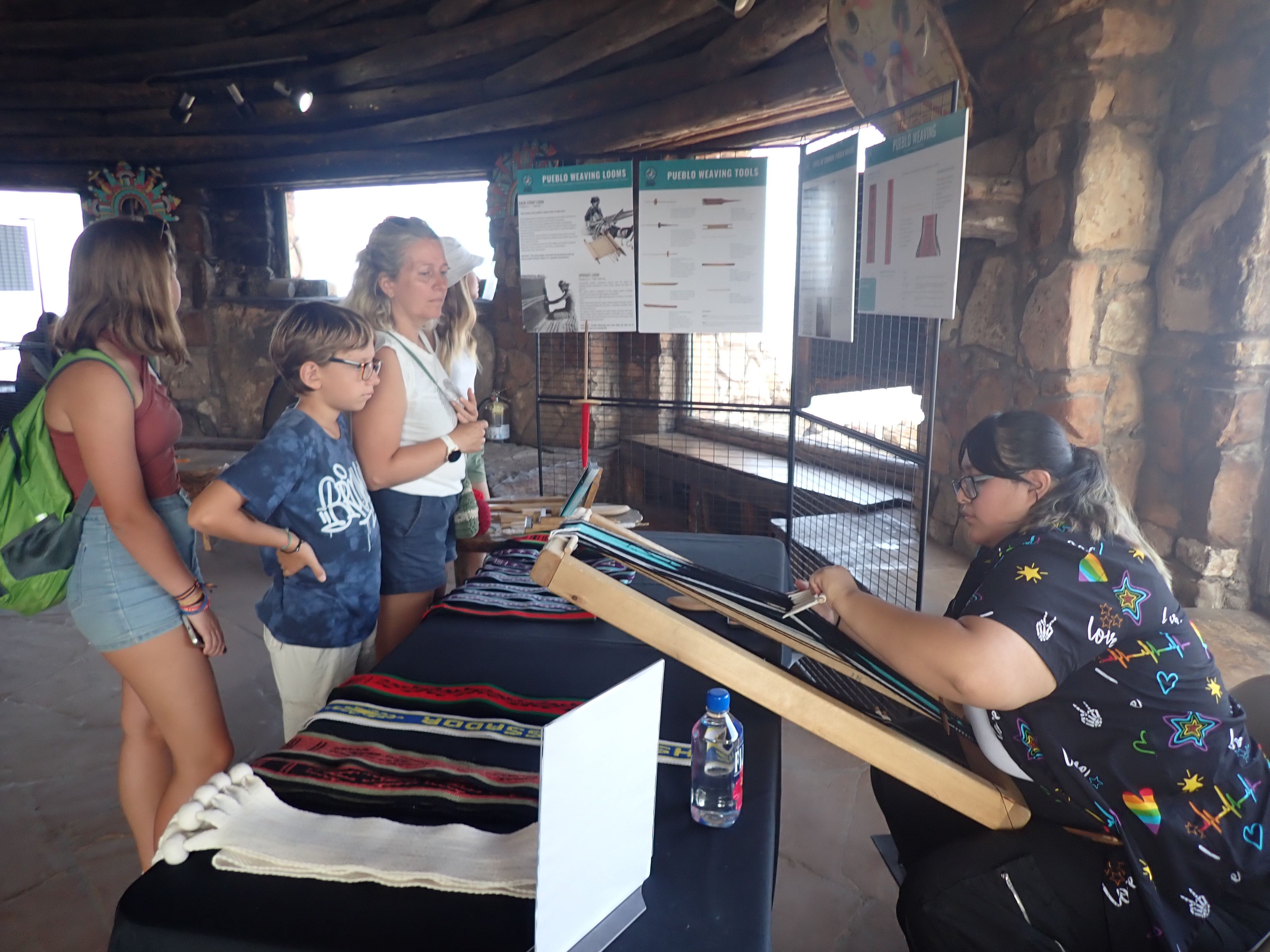
- Details
- By Native News Online Staff
Last month, three young artists from the Pueblo of Zuni had the opportunity to share their culture, history and traditional arts with the public through the Grand Canyon Cultural Demonstration Program. They are LaShea Harris, 24; Chasady Simplicio, 19; and Cassandra Tsalate, 21.
All three young people participated in the Zuni Youth Enrichment Project’s Emerging Artist Apprenticeship program, and Harris and Tsalate also completed the Advanced Artist Apprenticeship program. Kandis Quam, ZYEP’s assistant art coordinator, chaperoned the trip.
“We monitor our art students to see who has the capabilities to do something like this,” said Elroy Natachu Jr., ZYEP’s art coordinator. “We’re looking for young people with a solid work ethic and mental fortitude. They need to be motivated, self-driven, and able to push outside their comfort zone. With these three, we saw that light.”
The free cultural demonstrations took place from 9 a.m. to 4 p.m. daily at various locations at and around Desert View Watchtower, the easternmost developed area along the park’s South Rim. The artists also conducted demonstrations for other youth at Grand Canyon High School; in both cases, the artists said they appreciated the opportunities to engage with the public.

“I was nervous at first, but I really liked talking to people,” said Simplicio, who creates traditional Zuni Pueblo weaving. “People wanted to know how long it takes to produce a piece. I explained that it depends on the weaver, and on the design. One woman was so interested in our weaving process; she had her own small loom to fix socks. I thought that was cool!”
The three artists shared living quarters while in residence at Grand Canyon National Park, and Simplicio noted this gave the trio opportunities to get to know each other better.
“We talked about meaning, color and design in our work,” they remembered. “I learned a lot from LaShea and Cassandra.”
Harris said she also felt “a lot of nerves” before the program started, in part because she embarked on her journey with traditional Zuni embroidery just a year ago.
“It was a little bit intimidating, but I enjoyed sharing what I knew,” she recalled. “It was a popular time for European tourists, and we introduced them to Zuni art.”
“I was trying not to be nervous,” said Tsalate, who produces Zuni Pueblo pottery, with a laugh. “I told myself it was like trying to teach someone here at home. The ranger told us to ask ourselves, what is one thing we can leave them with?
“So, I talked about the significance of these traditional arts in our culture, and what revitalizing them means for the future of our people,” she continued. “I also talked about being passionate about culture and history. That’s what makes me motivated… the history! Hopefully we inspired others.”
Indeed, through the cultural demonstration program, these young artists became teachers for peers and adults alike. Natachu said this is vital for the future of the Zuni people.
“Our art forms are culturally rooted,” he explained. “They share how we view the world. They show it through our Zuni lens. Without future culture bearers, the knowledge of these traditional art forms will be lost — the artistic processes, and what they were meant for.”
Tsalate said she hopes the cultural demonstration program encouraged others to embrace their talents, especially women. And, back home, she hopes more Zuni youth will get more deeply involved with art and culture.
To that end, Harris said ZYEP’s Emerging Artist Apprenticeship Program is a good place for young people to start exploring their interests, passions and talents in the arts. The program not only provides art instruction, it also connects young artists with experienced mentors who can help guide them on their artistic journeys.
“Our experience at the Grand Canyon shows how far the apprenticeships can take you,” Harris observed. “You never know what doors will open. It’s great that ZYEP offers these opportunities, exposing youth to different arts and showing them that they can do it.”
While the group were able to visit a few of the tourist sites along the South Rim during their stay, their main focus was their artwork and strengthening connections to their roots in a place that is sacred to the Zuni people.
“It was so scenic, and there was the cultural significance as well,” Harris said. “It felt different to do my embroidery there. I felt closer to our ancestors.”
Grand Canyon has been home to 11 tribes for generations, which means it is more than a national park, a World Heritage Site and a natural wonder of the world. It’s also a sacred space for entire peoples: Havasupai, Hualapai, Hopi, Yavapai-Apache, Kaibab band of Southern Paiute, Las Vegas band of Southern Paiute, Moapa band of Southern Paiute, Paiute Indian Tribes of Utah, San Juan Southern Paiute Tribe, and Zuni.
The purpose of the Cultural Demonstration Program is to give members of those 11 traditionally associated tribes a voice at Grand Canyon by supporting interactions with the public through demonstrations of traditional Native practices and crafts. Made possible by grants from the Grand Canyon Conservancy, the program began in 2014 and continues to grow.
Now that she is back home, Harris said she is planning to take time to create something new. As she takes on larger embroidery projects, she is dedicated to further developing her own style.

Simplicio agreed, noting they plan to continue working on their weaving and learning more advanced techniques.
“I want to help my community by inspiring others, and showing them that you can make it as an artist, even if you’re a young person,” they said. “It’s always worth it to try something new.”
As for Tsalate, continuing with her pottery is one piece of a larger puzzle. Not only would she like to explore other mediums, like jewelry and basketry, she is pursuing an education in museum studies.
“I want to teach history,” she explained. “It’s so important. I want to open up conversations with our elders and encourage them to teach, as well.
“I also want to be in touch with other artists, people of all ages,” she continued. “It’s about bringing our community together, and improving access to outside resources like museums and national parks. I’m just so inspired.”
After this first experience with the Grand Canyon Cultural Demonstration Program, Natachu said he anticipates that this will become a regular part of ZYEP arts programming.
“We need to support the young people who have the capability to carry the torch into the future,” he said. “They must take our places one day.”
More Stories Like This
Deb Haaland Announces Education Platform, Secures Teachers Union BackingNative Americans Could Be Hit Hard as Education Department Resumes Student Loan Wage Garnishment
Hanging a Red Dress for Christmas: MMIP, Native Higher Education, and Hope for a Better New Year
Native Students Can Win $5,000 Scholarship, International Distribution in Pendleton Design Contest
American Indian College Fund Raises Alarm Over Plan to Shift Native Programs Away From the Dept. of Education
Help us defend tribal sovereignty.
At Native News Online, our mission is rooted in telling the stories that strengthen sovereignty and uplift Indigenous voices — not just at year’s end, but every single day.
Because of your generosity last year, we were able to keep our reporters on the ground in tribal communities, at national gatherings and in the halls of Congress — covering the issues that matter most to Indian Country: sovereignty, culture, education, health and economic opportunity.
That support sustained us through a tough year in 2025. Now, as we look to the year ahead, we need your help right now to ensure warrior journalism remains strong — reporting that defends tribal sovereignty, amplifies Native truth, and holds power accountable.
 The stakes couldn't be higher. Your support keeps Native voices heard, Native stories told and Native sovereignty defended.
The stakes couldn't be higher. Your support keeps Native voices heard, Native stories told and Native sovereignty defended.
Stand with Warrior Journalism today.
Levi Rickert (Potawatomi), Editor & Publisher


